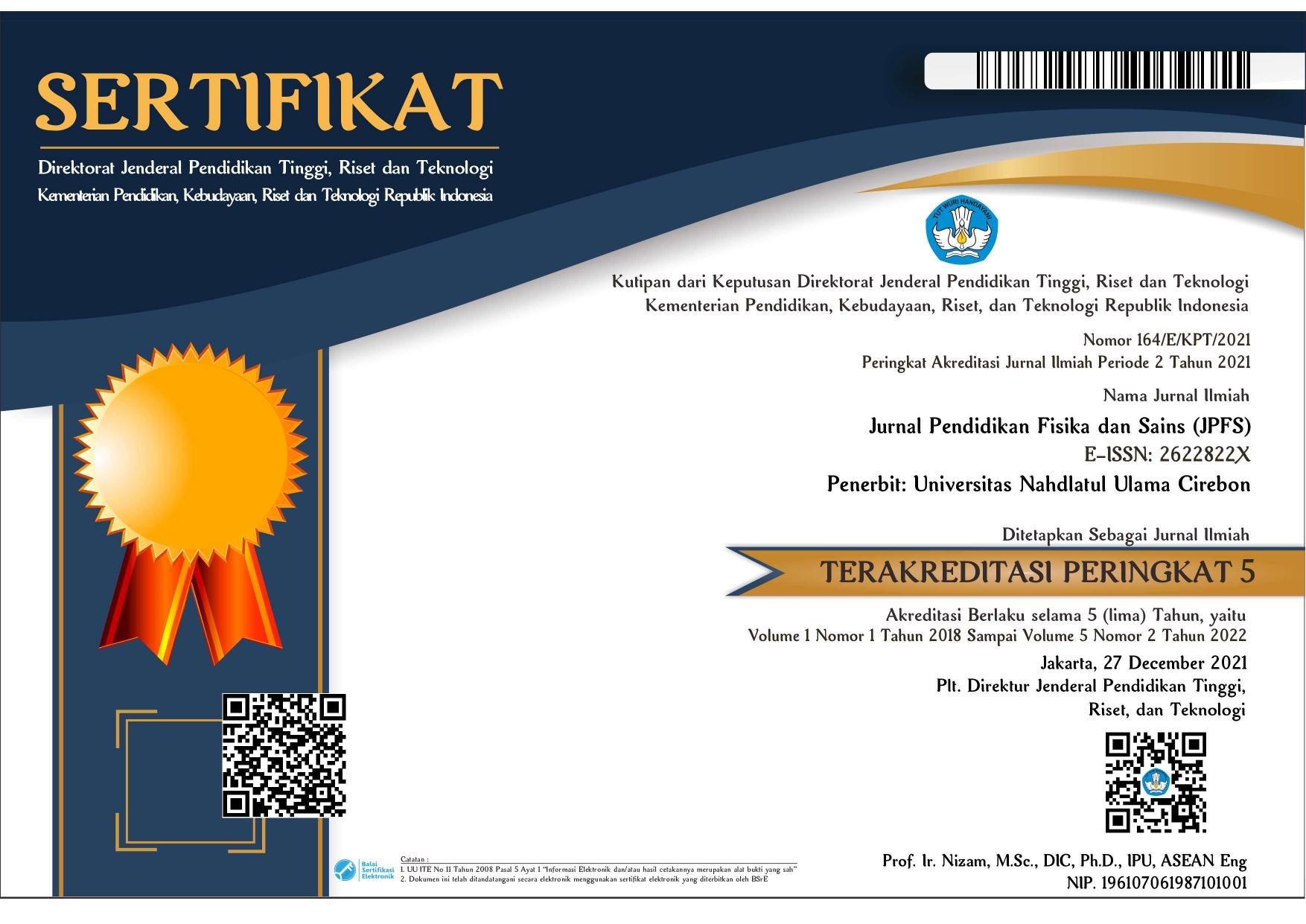Eksperimen Gerak Jatuh Bebas: Kajian Hubungan Jarak dan Waktu dalam Menentukan Percepatan Gravitasi Bumi
DOI:
https://doi.org/10.52188/jpfs.v8i2.1497Keywords:
Gerak jatuh bebas, percepatan gravitasi, regresi linearAbstract
Penelitian ini bertujuan untuk mengkaji hubungan antara jarak dan waktu dalam gerak jatuh bebas serta menentukan percepatan gravitasi bumi secara eksperimental. Metode yang digunakan adalah eksperimen deskriptif dengan mengukur waktu jatuh sebuah bola kecil dari beberapa ketinggian yang telah ditentukan secara vertikal. Pengukuran waktu dilakukan menggunakan stopwatch digital dengan ketelitian tinggi dan diulang beberapa kali untuk memperoleh data yang valid. Data yang diperoleh dianalisis dengan memplot grafik jarak terhadap kuadrat waktu, kemudian dilakukan regresi linear untuk menentukan gradien garis lurus. Nilai percepatan gravitasi bumi (g) dihitung berdasarkan gradien tersebut menggunakan persamaan gerak lurus berubah beraturan. Hasil eksperimen menunjukkan adanya hubungan kuadrat yang signifikan antara jarak dan waktu jatuh, sesuai dengan teori gerak jatuh bebas. Nilai percepatan gravitasi yang diperoleh mendekati nilai standar 9,8 m/s², meskipun terdapat sedikit variasi akibat faktor eksternal seperti hambatan udara dan ketelitian alat ukur. Penelitian ini menegaskan bahwa eksperimen gerak jatuh bebas merupakan metode yang efektif dan praktis untuk menentukan percepatan gravitasi bumi serta memberikan pengalaman belajar yang penting dalam pendidikan fisika.
References
Ahmed, R., & Khan, S. (2023). Application of Arduino-based sensors in free fall experiments. International Journal of Physics and Technology, 9(3), 120-128.
Ahmed, S., & Malik, T. (2020). A comparative study of methods to determine gravitational acceleration. Journal of Experimental Physics, 68(6), 455-462.
Brown, T., & Green, P. (2022). Revisiting Galileo’s free fall experiments with modern technology. European Journal of Physics Education, 43(2), 78-85.
Chen, L., & Huang, Y. (2020). Free fall motion and its applications in physics education. Journal of Science Teaching, 45(6), 345-352.
Chen, Y., & Wang, X. (2017). Precision measurement of gravitational acceleration using photogate sensors. Measurement Science Review, 17(4), 210-217.
Evans, M., & Johnson, K. (2016). Data analysis techniques for free fall experiments. Physics Education Research, 12(3), 210-218.
Garcia, M., & Lopez, J. (2019). Using smartphone sensors to measure acceleration due to gravity. Physics Teacher, 57(5), 300-305.
Giancoli, D. C. (2014). Physics: Principles with Applications (7th ed.). Boston, MA: Pearson.
Halliday, D., Resnick, R., & Walker, J. (2014). Fundamentals of Physics (10th ed.). Hoboken, NJ: Wiley.
Johnson, D., & Miller, A. (2014). The role of air resistance in free fall motion: An experimental approach. European Journal of Physics, 35(1), 015012.
Kim, S., & Choi, J. (2021). Experimental verification of gravitational acceleration on different planets using simulation. Physics Education Research, 16(2), 89-96.
Kumar, R., & Singh, P. (2018). Investigating the impact of timing errors in free fall experiments. Physics Education Research, 14(1), 33-40.
Kumar, S., & Verma, A. (2014). Determination of gravitational acceleration using pendulum and free fall methods. International Journal of Physics Education, 29(1), 15-22.
Lee, K. H., & Park, S. J. (2016). Analysis of air resistance effects on free fall experiments. International Journal of Physics Research, 12(2), 45-52.
Lopez, A., & Martinez, E. (2023). Novel methods for measuring gravitational acceleration in classroom settings. Physics Teacher Education, 58(1), 15-22.
Martinez, S., & Gomez, R. (2017). Theoretical and experimental study of free fall with air resistance. Journal of Applied Mechanics, 84(11), 111008.
Nguyen, T., & Tran, L. (2017). Error analysis in free fall experiments using electronic timing. International Journal of Science Education, 39(8), 1023-1035.
Oliveira, P., & Silva, R. (2016). Low-cost apparatus for measuring gravitational acceleration. Physics Education, 51(2), 025011.
Park, J., & Lee, M. (2019). Using laser sensors to improve accuracy in free fall experiments. Measurement, 134, 123-130.
Patel, N., & Desai, K. (2018). Enhancing accuracy in free fall experiments through digital data acquisition. Journal of Applied Physics, 123(9), 094501.
Roberts, J., & Evans, S. (2019). Investigating the effect of initial velocity in free fall experiments. American Journal of Physics, 87(3), 210-216.
Serway, R. A., & Jewett, J. W. (2018). Physics for Scientists and Engineers (10th ed.). Boston, MA: Cengage Learning.
Silva, M., & Costa, F. (2022). The influence of environmental factors on free fall experiments. Journal of Physics Experiments, 74(5), 567-574.
Singh, V., & Sharma, D. (2021). Impact of measurement uncertainty in determining gravitational acceleration. Physics Review Letters, 127(14), 140401.
Smith, J. R., & Brown, L. M. (2015). Experimental determination of gravitational acceleration using free fall method. Journal of Physics Education, 50(3), 123-130.
Tanaka, H., & Saito, M. (2015). Free fall experiments in microgravity environments. Advances in Space Research, 56(7), 1345-1352.
Tipler, P. A., & Mosca, G. (2008). Physics for Scientists and Engineers (6th ed.). New York, NY: W. H. Freeman.
Wang, L., & Zhao, Q. (2020). Using video analysis to study free fall motion. Physics Education, 55(4), 045012.
Wilson, R., & Taylor, J. (2018). Experimental challenges in measuring gravitational acceleration. Physics Reports, 720-722, 1-20.
Zhao, H., & Liu, X. (2015). Free fall experiments using smartphone accelerometers. Physics Education, 50(5), 550-555.
Published
How to Cite
Issue
Section
Copyright (c) 2025 Diana Fitriwati, Rafli Hakam Sepudin, Denia Maulani Hindasah, Adam Malik

This work is licensed under a Creative Commons Attribution 4.0 International License.
Copyright Transfer Agreement
The Authors submitting a manuscript do so on the understanding that if accepted for publication, copyright of the article shall be assigned to Jurnal Pendidikan Fisika dan Sains (JPFS) and Physics Education Programs of UNU Cirebon as publisher of the journal.
Copyright encompasses exclusive rights to reproduce and deliver the article in all form and media, including reprints, photographs, microfilms and any other similar reproductions, as well as translations. The reproduction of any part of this journal, its storage in databases and its transmission by any form or media, such as electronic, electrostatic and mechanical copies, photocopies, recordings, magnetic media, etc. , will be allowed only with a written permission from Jurnal Pendidikan Fisika dan Sains (JPFS) and UNU Cirebon.
Authors are permitted to disseminate published articles by sharing the link/DOI of the article at the journal. Authors are allowed to use their articles for any legal purposes deemed necessary without written permission from the journal with an acknowledgment of initial publication to this journal.
Jurnal Pendidikan Fisika dan Sains (JPFS) and UNU Cirebon and the Editorial Board make every effort to ensure that no wrong or misleading data, opinions or statements be published in the journal. In any way, the contents of the articles and advertisements published in the Jurnal Pendidikan Fisika dan Sains (JPFS) are sole and exclusive responsibility of their respective authors and advertisers.





















